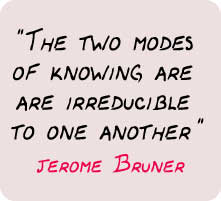|
|
Katalina Groh, Larry Prusak: Some of the world's leading thinkers |
| Two modes of knowing: abstract and narrative |

|
"Let me begin by setting out my argument as baldly as possible, better to examine its basis and its consequences. It is this. There are two modes of cognitive functioning, two modes of thought, each providing distinctive ways of ordering experience, of constructing reality. The two (though complementary) are irreducible to one another. Efforts to reduce one mode to the other or to ignore one at the expense of the other inevitably fail to capture the rich diversity of thought. |
| Each of the ways
of knowing, moreover, has operating principles of its own and its own
criteria of well-formedness. They differ radically in their procedures
for verification. A good story and a well-formed argument are
different natural kinds. Both can be used as means for convincing another.
Yet what they convince of is fundamentally different: arguments
convince one of their truth, stories of their lifelikeness. The one verifies
by eventual appeal to procedures for establishing formal and empirical
proof. The other establishes not truth but verisimilitude. It has been
claimed that the one is a refinement of or an abstraction from the other.
But this must be either false or true only in the most unenlightening
way.... Let me quickly and lightly characterize the two modes so that I may get on more precisely with the matter. One mode, the paradigmatic or logico-scientific one, attempts to fulfill the ideal of a formal, mathematical system of description and explanation. It employs categorization or conceptualization and the operations by which categories are established, instantiated, idealized, and related one to the other to form a system... At gross level, the logico-scientific mode (I shall call it paradigmatic hereafter) deals in general causes, and in their establishment, and makes use of procedures to assure verifiable reference and to test for empirical truth. Its language is regulated by requirements of consistency and non-contradiction. Its domain is defined not only by observables to which its basic statements relate, but also by the set of possible worlds that can be logically generated and tested against observables — that is, it is driven by principled hypotheses.... The imaginative application of the narrative mode leads instead to good stories, gripping drama, believable (though not necessarily "true") historical accounts. It deals in human or human-like intention and action and the vicissitudes and consequences that mark their course. It strives to put its timeless miracles into the particulars of experience, and to locate the experience in time and place. Joyce thought of the particularities of the story as epiphanies of the ordinary. The paradigmatic mode, by contrast, seeks to transcend the particular by higher and higher reaching for abstraction, and in the end disclaims in principle any explanatory value at all where the particular is concerned. From Jerome Bruner, Actual Minds, Possible Worlds, Harvard University Press, Boston, 1986, page 11-13 |
| Books and videos on storytelling *** In Good Company : How Social Capital Makes Organizations Work by Don Cohen, Laurence Prusak (February 2001) Harvard Business School Press *** The Social Life of Information, by John Seely Brown, Paul Duguid (February 2000) Harvard Business School Press *** The Springboard : How Storytelling Ignites Action in Knowledge-Era Organizations by Stephen Denning (October 2000) Butterworth-Heinemann *** The Art of Possibility, a video with Ben and Ros Zander : Groh Publications (February 2001) |
| The views expressed on this website are those of the authors, and not necessarily those of any person or organization |
| Site optimized in 800x600: webmaster CR WEB CONSULTING |
|
|
|
|